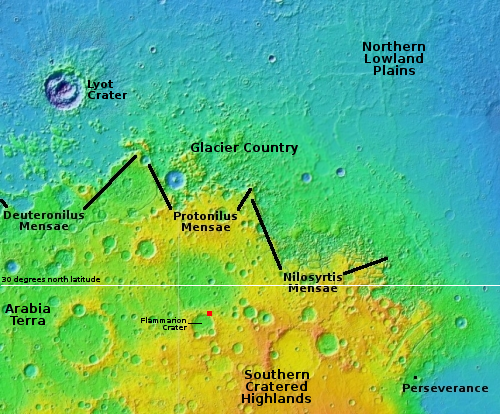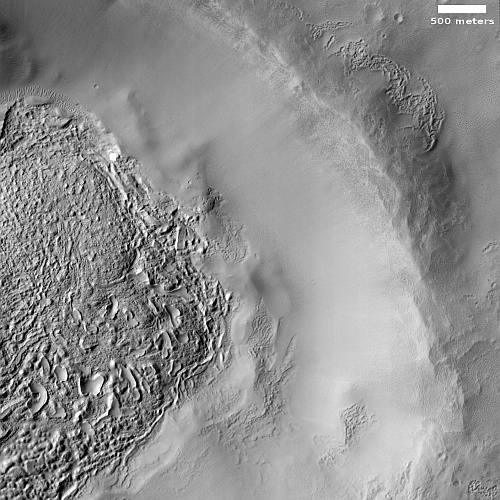Glacial evidence in the dry equatorial regions of Mars?
Cool image time! The picture to the right, rotated, cropped, rotated, and sharpened to post here, was taken on June 3, 2023 by the high resolution camera on Mars Reconnaissance Orbiter (MRO). It shows the eastern half of a six-mile-wide unnamed crater with a depth of about 1,500 to 2,000 feet from rim to floor.
What makes this picture significant is the patchy material in the center of that crater floor, some of which looks almost like very old peeling paint. It also resembles the kind of glacial features routinely seen in many craters poleward of 30 degrees latitude on Mars.
Is this another example of such glacial features? If so, its location is what makes it significant.

The red dot on the overview map to the right, just outside the northeast rim of 107-mile-wide very ancient and eroded Flammarion Crater, marks the location of this smaller crater. Flammarion has geological features that suggest to some scientists that a lake once existed there.
More significant is the latitude, 26.5 degrees north. If that patchy material in the floor of the crater above is eroding ice, then this is one of the closest locations to the equator where such near-surface ice has been found. If this is ice, then it might be worthwhile to monitor the crater floor to see if there are any changes over time. This close to the equator any recently exposed ice will sublimate away relatively quickly.
Unfortunately, only one previous MRO hi-res image has been taken, of the western half of this crater in August 2012. There is only a little overlap, which makes detecting any changes in the subsequent decade difficult.
It is also possible we are looking at some form of impact melt, created when the crater formed and only recently exposed. I am not enthused by this possibility, but it cannot be dismissed.
On Christmas Eve 1968 three Americans became the first humans to visit another world. What they did to celebrate was unexpected and profound, and will be remembered throughout all human history. Genesis: the Story of Apollo 8, Robert Zimmerman's classic history of humanity's first journey to another world, tells that story, and it is now available as both an ebook and an audiobook, both with a foreword by Valerie Anders and a new introduction by Robert Zimmerman.
The print edition can be purchased at Amazon or from any other book seller. If you want an autographed copy the price is $60 for the hardback and $45 for the paperback, plus $8 shipping for each. Go here for purchasing details. The ebook is available everywhere for $5.99 (before discount) at amazon, or direct from my ebook publisher, ebookit. If you buy it from ebookit you don't support the big tech companies and the author gets a bigger cut much sooner.
The audiobook is also available at all these vendors, and is also free with a 30-day trial membership to Audible.
"Not simply about one mission, [Genesis] is also the history of America's quest for the moon... Zimmerman has done a masterful job of tying disparate events together into a solid account of one of America's greatest human triumphs."--San Antonio Express-News
Cool image time! The picture to the right, rotated, cropped, rotated, and sharpened to post here, was taken on June 3, 2023 by the high resolution camera on Mars Reconnaissance Orbiter (MRO). It shows the eastern half of a six-mile-wide unnamed crater with a depth of about 1,500 to 2,000 feet from rim to floor.
What makes this picture significant is the patchy material in the center of that crater floor, some of which looks almost like very old peeling paint. It also resembles the kind of glacial features routinely seen in many craters poleward of 30 degrees latitude on Mars.
Is this another example of such glacial features? If so, its location is what makes it significant.

The red dot on the overview map to the right, just outside the northeast rim of 107-mile-wide very ancient and eroded Flammarion Crater, marks the location of this smaller crater. Flammarion has geological features that suggest to some scientists that a lake once existed there.
More significant is the latitude, 26.5 degrees north. If that patchy material in the floor of the crater above is eroding ice, then this is one of the closest locations to the equator where such near-surface ice has been found. If this is ice, then it might be worthwhile to monitor the crater floor to see if there are any changes over time. This close to the equator any recently exposed ice will sublimate away relatively quickly.
Unfortunately, only one previous MRO hi-res image has been taken, of the western half of this crater in August 2012. There is only a little overlap, which makes detecting any changes in the subsequent decade difficult.
It is also possible we are looking at some form of impact melt, created when the crater formed and only recently exposed. I am not enthused by this possibility, but it cannot be dismissed.
On Christmas Eve 1968 three Americans became the first humans to visit another world. What they did to celebrate was unexpected and profound, and will be remembered throughout all human history. Genesis: the Story of Apollo 8, Robert Zimmerman's classic history of humanity's first journey to another world, tells that story, and it is now available as both an ebook and an audiobook, both with a foreword by Valerie Anders and a new introduction by Robert Zimmerman.
The print edition can be purchased at Amazon or from any other book seller. If you want an autographed copy the price is $60 for the hardback and $45 for the paperback, plus $8 shipping for each. Go here for purchasing details. The ebook is available everywhere for $5.99 (before discount) at amazon, or direct from my ebook publisher, ebookit. If you buy it from ebookit you don't support the big tech companies and the author gets a bigger cut much sooner.
The audiobook is also available at all these vendors, and is also free with a 30-day trial membership to Audible.
"Not simply about one mission, [Genesis] is also the history of America's quest for the moon... Zimmerman has done a masterful job of tying disparate events together into a solid account of one of America's greatest human triumphs."--San Antonio Express-News


